All published articles of this journal are available on ScienceDirect.
A Bibliometric Analysis of Ophthalmology, Medicine, and Surgery Journals: Comparing Citation Metrics and International Collaboration
Abstract
Objective:
To evaluate SCImago’s top ranked ophthalmology journals, comparing them with the top medical and surgical journals.
Methods:
Data over 20 years was extracted for the top-ranked 20 ophthalmology, top 5 medical, and top 5 surgical journals based on SCImago Journal Ranking (SJR). Trends in SJR, self-citations, external citations per document, uncited documents, international collaboration, citations per document, and total citations were identified. ANCOVA analysis was utilized to further characterize average trends over time between medicine, ophthalmology and surgery.
Results and Discussion:
The fields of medicine, ophthalmology, then surgery had the highest SJR while medicine, surgery, then ophthalmology had the highest h-indices. Medicine had 1.01 uncited per cited article, compared to 0.54 and 0.43 for ophthalmology and surgery. Percent of self-citation was 5.9% for ophthalmology, 5.0% for surgery, and 0.56% for medicine; however, self-citations per article were the highest for surgery. International collaboration was highest for ophthalmology (19.14%) compared to surgery (16.75%) and medicine (8.00%). Medicine increased disproportionately in SJR (p= 0.0037), citations per document (p <0.001), and total citations (p<0.001) compared to surgery and ophthalmology over the last 20 years. Ophthalmology had the largest decrease in the percent of uncited articles (p=0.0006).
Conclusion:
Ophthalmology has a lower h-index compared to surgery and medicine but was comparable when using more qualitative measures including SJR and uncited articles. Ophthalmology has the highest number of self-citations and the greatest level of international collaboration.
1. INTRODUCTION
Scientometrics, a sub-field of bibliometrics, provides an objective method of evaluating the impact and relevance of scientific research through quantitative, qualitative, and collaborative indicators [1, 2]. Metrics are used to reveal trends and evaluate productivity at specialty, institution, article, or individual researcher levels and have thus become inextricably linked to academic success and funding opportunities [3]. Given the increasing number of publications across specialties, there is growing interest in evaluating bibliometric trends [4]. Bibliometric analyses of top articles for various surgical subspecialties have been published, permitting transparency and understanding of quality research in those fields, as well as in ophthalmology [5-8]. Similar analyses have also been done comparing trends between different medical and surgical specialties [9, 10].
SCImago is a well-established online journal ranking platform (www.scimagojr.com) that ranks based on its own (Elsevier B.V.) proprietary SJR indicator. SCImago pulls multivariate data from Elsevier’s Scopus database (www.elsevier.com/solutions/scopus). The SCImago Journal Rank (SJR) indicator was created to “rate” a journal’s success and is based on a complex algorithm originally defined in network theory. Like many other ranking variables, it is largely influenced by citation quantity and the origin of each citation. One critical aspect of the SJR is that it is designed to be unbiased by journal size, or “size-independent” [11]. Thus, it makes for adequate comparisons across fields and specialties. When a high ranking journal cites an article, impact on the SJR is attributed to that particular journal [12]. Further, it measures the scientific influence of the average article from a journal and expresses how important the average article is to the global scientific discussion. In addition, SCImago describes the SJR as measuring the impact, influence, or prestige of a journal by representing the average number of these weighted citations in a selected year by the documents published by that journal in the three previous years [13, 14].
Other important variables to assess a journal's success include the H-index and international collaboration. H-index is another metric displayed by SCImago to gauge prestige and impact. It is defined by the value of h that is derived when looking at the h number of papers that have been cited at least h times [15]. It is considered most relevant when comparing journals within the same field, unlike SJR. International collaboration has been shown to correlate with increased citations, publications, and impact, and is a positive indicator of progress and advancement in research [16-19].
The top-ranked journals of a given field are an important source of evidence-based medicine, best practice guidelines, medical education, and updates on the latest advances across the discipline. Research in ophthalmology is being published more rapidly than ever with increasing impact factors; however, few bibliometric analyses have been published in ophthalmology [20]. A limited number of previous studies have examined trends in specific topics or subspecialty representation over time, but none have detailed the overall productivity, impact, and quality of ophthalmology research compared to other medical specialties [4, 21, 22]. This paper aims to evaluate the trends in productivity and quality of ophthalmologic research through analysis of impact, citations, international collaboration, and other variables, in comparison to medicine and surgery journals using the SCImago Journal ranking database.
2. METHODS
Data from 1999 to 2018 was analyzed for the 20 highest-ranked ophthalmology journals, and 5 highest-ranked medicine and surgical journals, based on SCImago’s SJR indicator. A greater number of journals were analyzed for ophthalmology to allow for a more in-depth evaluation of ophthalmology, while capturing a general quantitative understanding of the fields of surgery and medicine for means of comparison. These top-ranked lists of ophthalmology, surgery, and medicine journals were found using filters provided by SCImago’s interface. The search was performed in May 2020. Two ophthalmology and one surgery journal were excluded from the analysis since they were less than 5 years old and lacked adequate data. These were Current Trauma Reports, Ophthalmic Epidemiology, and Current Trauma Reports. Five journals were retained for analysis that was under 20 years old; however, they were greater than 15 years old. These were Ocular Surface, Journal of Vision, Nature Reviews Genetics, Nature Reviews Cancer, and Nature Reviews Immunology.
Our primary outcomes were to evaluate for differences in the rates of self-citation, external citations per document, uncited documents, and international collaboration (article authors from at least two different countries) between ophthalmology journals, and between ophthalmology, medicine and surgery. Our secondary outcomes were to similarly evaluate for trends over time in all three fields for SJR, citations per document, and total citations.
Statistical modeling utilized SPSS v 22.0, an IBM platform, to perform linear regressions for the variables listed above from the 30 SCImago journals evaluated. From these regressions, we gathered r-squared values, year estimates, standard errors, and p-values. We also performed an Analysis of Covariance (ANCOVA) to compare these variables between the top 5 ophthalmology, medicine, and surgery journals. The ANCOVA permitted inter-field comparison of the primary and secondary outcomes against time (interaction effect). From the ANCOVAs, we obtained the maximum r-squared values and p-values for cumulative totals, years, journals, and changes in impact over the years (year-journals). Alpha was set at 0.05.
3. RESULTS
The mean SJR for the top 5 journals in each discipline was 41.23 for medicine, 3.88 for ophthalmology, and 3.5 for surgery (Table S1 a-c). Cumulative citations for the top 5 were recorded over 20 years: medicine (522,189), surgery (375,110), and ophthalmology (270,818). No correlation was found between h-index and SJR within ophthalmology and surgery, whereas medicine had a strong inverse relationship (r= 0.31, 0.04, and -0.87). Medicine had the highest average h-index at 269, followed by surgery at 189.8, and ophthalmology at 150.4. Citations per document fell in the same order: 33.89 (medicine), 5.61 (surgery), and 5.28 (ophthalmology). Citations per document from the last two years showed medicine with many more (85.01) compared to ophthalmology (7.62) and surgery (7.53). The ratio of uncited to cited articles found that ophthalmology and surgery produced around half the number of uncited as cited articles (0.54 and 0.43). Medicine had a larger percentage of uncited articles, having one uncited for every cited article produced (1.01). Finally, the number of references per document in 2018 alone for medicine, ophthalmology, and then surgery were 90.21, 68.39, and 22.79, respectively.
The proportion of self-citations to total citations in the last 3 years was 5.9% for ophthalmology journals, 5.0% for surgery, and 0.56% for medicine journals (Table 1). An additional calculation was performed to find average self-citations per article produced for each field. Self-citations from each field were totaled from the last three years and divided by the total articles from the same period. Medicine had the lowest average at 0.53, followed by ophthalmology at 0.73, then surgery at 0.74. Further, Pearson’s correlation coefficients of external citations against self-citations were -0.619 for medicine, 0.325 for surgery, and -0.137 for ophthalmology. Thus, no strong relationships were found, though medicine did show a moderate negative correlation, suggesting that self-citations decrease with increasing external citations.
The average percent of international collaboration was highest for ophthalmology journals (19.14%) compared to surgery (16.75%) and medicine (8.00%). Morbidity and Mortality Weekly Report (MMWR), the second-ranked medicine journal, had just one year with any international collaboration (average for medicine increased to 10.02% when removing MMWR). There was an increase in international collaboration over time in all disciplines (Table 2). Of the 30 journals analyzed, 50% were from the United States, 30% from the United Kingdom, and 20% from the Netherlands. On average, journals from the United Kingdom averaged 19.80% international collaboration, while the average from the United States and the Netherlands were 16.8% and 15.86% respectively.
Univariate analysis was performed for the three fields to provide data necessary to perform ANCOVA analysis (Table S2 2 and 3). ANCOVA analysis was completed to study the relationships between the journal type and SJR, citations per document, international collaborations, external citations, uncited articles, self-citations, and total citations (Table 3 and Fig. 1a-1g). The current top 5 journals in medicine increased disproportionately in comparison to surgery and ophthalmology in SJR (Fig. 1a, p=0.004), citations per document (Fig. 1b, p<0.001), and total citations (Fig. 1c, p<0.001). All journals increased in international collaborations; however, the rate of change in international collaboration over time was greatest for ophthalmology (Fig. 1d, p<0.004). Fig. 1e, which shows the percentage of external citations, also shows ophthalmology increasing at the greatest rate but not significantly compared to medicine and surgery (p=0.33). Contrast this to the evaluation of self-citations in Fig. (1f), which shows each journal type decreasing over time, but there was not a significant difference in the rate of change (p=0.56). The ratio of cited over total cited and uncited articles in Fig. (1g) represents the percent of articles a journal published that went on to become cited. Ophthalmology started with the lowest percent of cited articles and progressed over the last 20 years to be as equally cited as the top surgical journals (p<0.001). Conclusively, medicine and surgery have not changed significantly over time regarding the percentage of uncited articles, but medicine produced the smallest portion of cited articles.
| - | 1999-2003 | 2003-2007 | 2008-2013 | 2014-2018 |
| Ophthalmology | 8.30% | 7.10% | 7.04% | 5.99% |
| Medicine | 3.08% | 1.25% | 0.94% | 0.60% |
| Surgery | 5.44% | 5.95% | 5.19% | 5.12% |
| - | 1999-2003 | 2003-2007 | 2008-2013 | 2014-2018 |
| Ophthalmology | 11.18% | 17.38% | 21.28% | 26.32% |
| Medicine | 5.84% | 8.67% | 10.84% | 13.69% |
| Surgery | 10.01% | 14.60% | 18.47% | 23.89% |
| - | P-value, C. total | P-value, Journal | P-value, Year-Journal |
| SJR | <.0001 | <.0001 | 0.0037 |
| Cites / Doc. (3 years) | <.0001 | <.0001 | <.0001 |
| Total Cites | <.0001 | <.0001 | <.0001 |
| International Collaboration | <.0001 | <.0001 | 0.0037 |
| External Cites / Total Cites | <.0001 | <.0001 | 0.3347 |
| Self Cites / Total Cites | <.0001 | <.0001 | 0.5574 |
| Cited / Cited + Uncited | <.0001 | <.0001 | 0.0006 |
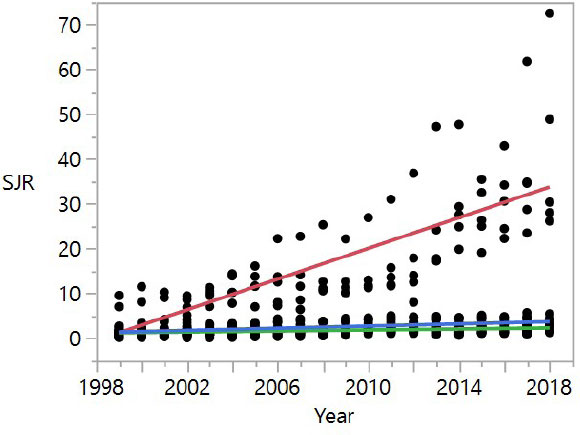

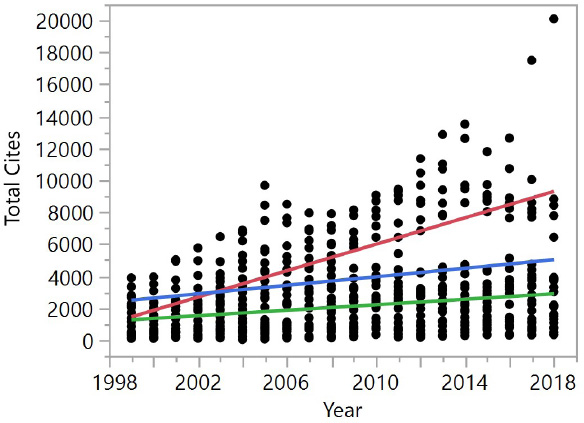
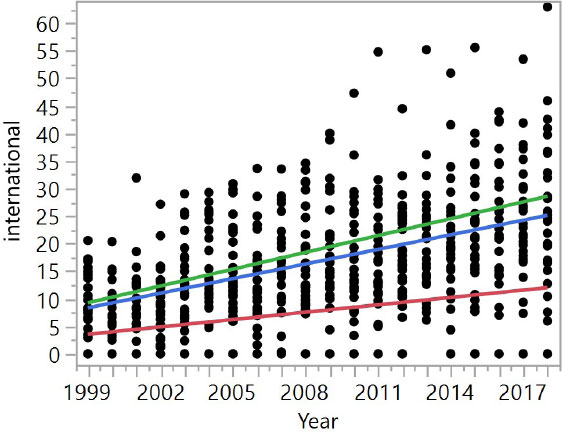
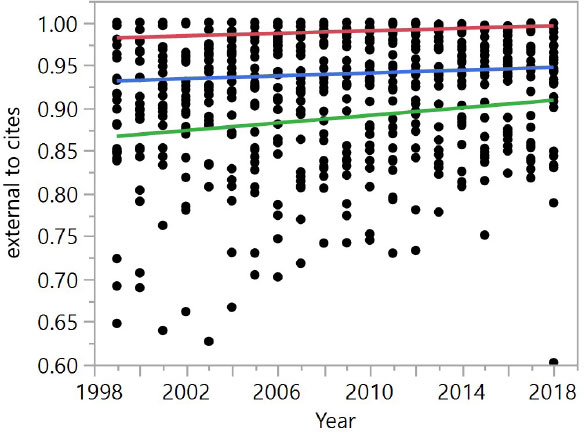

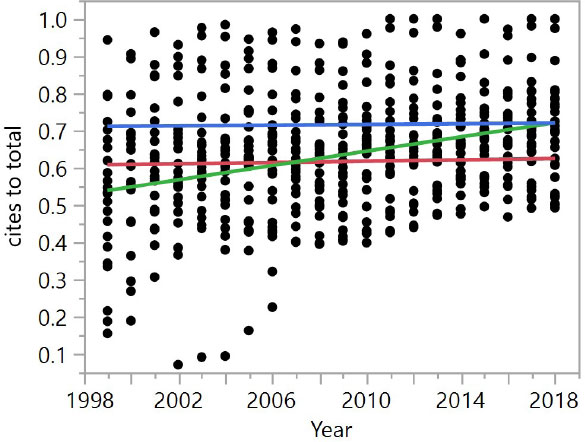

4. DISCUSSION
The SJR is a well-accepted tool for evaluating medical journals in scientometric analysis [23]. Fields with larger audiences and broader scopes, acquire proportional numbers of citations, for example medicine with significantly more citations over the last twenty years. In the same respect, surgery, still broader than the surgical subspecialty of ophthalmology, had more citations. The average SJR, however, was higher for ophthalmology than surgery. This highlights the utility of ranking indicators being based on more than just the number of citations. A narrower scope, then, does not dictate the research generated [11]. Ophthalmic journals publishing reviews, basic science, and broad-range topics rank higher for impact factor than subspecialty journals [24]. In addition, many of the higher impact randomized-controlled trials are published in non-ophthalmology journals, influencing the impact factor. In an analysis of ophthalmology journals from 1997-2009, other specialties had up to a ten times higher impact factor, but ophthalmology was average on journal impact factor and cited half-life [25].
Critically, ophthalmology journals had the greatest international collaboration. A recent review on international collaboration noted its importance as science, technology, and innovation are becoming increasingly more of a global and collaborative undertaking [26]. Our data shows a consistent upward trend in international collaboration across all three fields, likely driven by the higher productivity and greater impact of collaborative research [27]. Of the three fields, ophthalmology increased at the fastest rate; the drivers likely being a smaller, more specialized field necessitating more outreach in the pursuit of goals, and perhaps a more uniform geographic distribution. The U.S. holds just ten percent of ophthalmologists worldwide, lending its hand to the utility of international collaboration [28].
Around half (54%) of the articles produced in ophthalmology were cited. While medicine had considerably more uncited articles than surgery and ophthalmology. The articles that are cited in medicine, however, go on to receive considerably more citations. Nature Reviews Immunology (the Nature Reviews platform makes up 3 of the top 5 medicine journals) contains 3,517 search results within the Web of Science. Of these 1,713 were news items, 1,065 were reviews, 424 were editorial material, and just 205 were actual manuscripts. Contrasting this to Ophthalmology with 17,756 search results yielding a significantly greater percentage of manuscripts at 11,661. If manuscripts are excluded that are not considered “research articles”, such as news items or reviews above, uncited article percentiles drop significantly. Some journal’s percentages of uncited articles percentages have been shown to vary as much as 80 percent depending on which types of articles are included in the calculation [29, 30].
Self-citation is, however, necessary for the evolution and progression of research, particularly in small fields such as ophthalmology [31]. Self-citation rates within ophthalmology are similar to those from the top 100,000 authors in research [32]. In the study by Noorden and Chawla, there was an average median rate of self-citation of 12.7% from 1996 to 2017 and 9.2% in 2017 alone [33]. Thus, although higher than the rates of medicine and surgery, ophthalmology self-cites modestly compared to research from all domains of science. High-impact journals tend to have a lower percentage of self-citation. We are critical of using the percentage of self-citation (self-citations divided by total citations for a journal) for comparison between fields. This is because the percentage is diluted by high total citations and so makes for poor scientometric comparison when comparing a field like medicine that receives many more total citations per article than a smaller field such as ophthalmology. For this reason, we propose using self-citation per article. We calculated this by dividing the journal’s self-citations by the number of articles, which controls for external citation. With this method, surgery had a slightly higher rate of self-citation per article followed by ophthalmology than medicine. To summarize, although a greater percentage of ophthalmology’s citations are self-citations, an article produced from a top surgery journal is likely to be self-cited more often.
A critical limitation of this study is small with respect to medicine and surgery. The decision to limit to five journals was based on the concept that five journals would provide a general scope of the field while eliminating influence from the lower-ranked journals which are less stable in rank. This permitted certain journal characteristics to dominate the top 5, namely the Nature Reviews series, making up 3 of the top 5 medicine journals. An additional limitation is our selection of SCImago as our basis for comparison, as opposed to other databases or methods of evaluating impact. Clarivate’s impact factor from the Web of Knowledge database, for example, could include journals that were not on our ranked lists or would change the order of ranked items [34]. Our purposes for selecting SCImago’s SJR discussed previously do not exclude a utility in a similar study being done based on a different ranking system. Another limitation is the date range used by SCImago. Our article used the most recent ranking which was based on data from 2018 and prior. This invariably would not represent real-time rankings as editing and publishing are constantly changing, and more specifically this would not account for possible significant changes that could have occurred secondary to the COVID-19 pandemic.
CONCLUSION
In conclusion, variables provided by SCImago used to define and rank journals were found to have statistical differences among the three fields. The number of uncited articles in ophthalmology was lower than in medicine and surgery, and self-citation and international collaboration were highest for ophthalmology. Further research into both self-citation and the impact of international collaboration in ophthalmology is needed.
LIST OF ABBREVIATIONS
| SJR | = SCImago Journal Ranking |
| ANCOVA | = Analysis of Covariance |
| MMWR | = Morbidity and Mortality Weekly Report |
ETHICS APPROVAL AND CONSENT TO PARTICIPATE
Data utilized was extracted from a public domain, SCImago, and involved no patient-related information thus requiring no specific permissions or approval.
HUMAN AND ANIMAL RIGHTS
No humans or animals were used for the studies that are the basis of this research.
CONSENT FOR PUBLICATION
Not applicable.
AVAILABILITY OF DATA AND MATERIAL
The data supporting the findings of the article is available in the Scimago database at https://www.scimagojr.com/.
FUNDING
No government or non-government support was received.
CONFLICTS OF INTEREST
The authors declare no conflicts of interest financial or otherwise.
ACKNOWLEDGEMENTS
Declared none.
DISCLOSURES
Annette K. Hoskin is a recipient of a Dora Lush NHMRC Ph.D. Scholarship. The view(s) expressed herein are those of the author(s) and do not reflect the official policy or position of Walter Reed National Military Medical Center, the U.S. Army Medical Department, the U.S. Army Office of the Surgeon General, the Department of the Air Force, the Department of the Army, Department of Defense, the Uniformed Services University of the Health Sciences or any other agency of the U.S. Government.
SUPPLEMENTARY MATERIAL
Supplementary material is available on the publisher’s website along with the published article.


